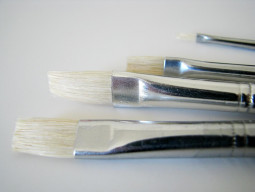
From Zahra Asim’s super-realist oil paintings to Arsalan Nasir’s playful puzzle-art pieces, the group show ‘Identifiable Localities’ depicted routine occurrences and everyday spaces in unexpected ways.
The exhibition, featuring six emerging artists, is being held at the IVS Gallery and, apart from a few exceptions, the works encapsulate a meditative, quiet mood.
Take for instance Fariha Taj’s line renderings of cityscapes. Taj conveys the energy of places, such as Boat Basin and Burnes Road, through a frenzy of lines, with the dark graphite in stark contrast to the white of the paper. The strokes form a messy web, suggesting the wires that run through the city but also evoke a cage-like effect.

‘Burns Road I’ by Fariha Taj conveys the chaos of Karachi. PHOTO COURTESY: IVS GALLERY
In her artist’s statement, Taj writes about how these lines are meant to suggest a sense of entrapment but thanks to her restrained approach the idea is not forced or heavy-handed. Instead, her style and technique require the viewer to slowly examine the pieces and it is only gradually that the more sinister aspects become apparent.
Mohammad Mujeeb’s two works, done in pen and ink, share many stylistic qualities with Taj’s. Both are monochromatic and comprise an intricate mass of lines. But the subjects could not be more different as Mujeeb’s inspiration comes from the Sindhi craft of leaf-weaving. Mimicking weave patterns through delicate hatching, Mujeeb’s works were perhaps the most abstract of the show as they did not depict any specific objects. Instead, the variations in darkness, which suggest depth, and the sprawling patterns remind one of topographical maps.
At the other end of the spectrum are Zahra Asim’s series of seven miniature-scaled paintings, titled ‘Roots,’ in which she depicts everyday spaces, such as bathroom sinks and unmade beds. Her style of painting, with its emphasis on realism, may be traditional but there is an overlying sense of urban ennui. The insignificance of the objects depicted - old television sets and plastic chairs - signify the insignificance of the lives of the owners and the small scale of the works is fitting as it gives the viewer the sense of peeking into the private worlds of others.
Also small in scale, but employing a completely different approach, were the two puzzles by Arsalan Nasir Hussain. Inspired by childhood playthings, his two interactive puzzles evoked a sense of nostalgia since, when solved, the puzzles depict childish drawings. Although the concept is novel, it perhaps could have been better conveyed to the viewers if more pieces from his collection were included in the show. With group shows it is understandable that only a few pieces of individual artists are included but sometimes the artworks lose their meaning when placed in isolation and - though this is more of curatorial concern than the artist’s fault - his work somewhat got lost amid the other works.
Sidra Asim’s mixed media works, in which she layers archetypal still-life objects, such as fruits, cushions and flowers over sepia drawings of people, seem to be meditations on how objects can bear memories of people and places. The brightly painted objects in the foreground are sharply juxtaposed by the sepia background and the laughing faces, fading into brown, have a phantom-like effect.
Then there are Wasif Afridi’s two works in which he depicts bleak, nightmarish images. Not only is the subject matter aggressive - screaming faces and splats presumably of blood - but so is the technique. Afridi uses a soldering rod to make burn marks on plywood and, in his statement, writes that the pyrography technique is a way for him to channel his emotions and aggression.
Published in The Express Tribune, April 11th, 2014.












































COMMENTS
Comments are moderated and generally will be posted if they are on-topic and not abusive.
For more information, please see our Comments FAQ